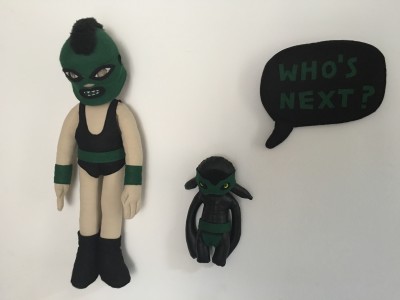
SLEEPLESS IN TÓRSHAVN (the complete saga)
Part 1: Teitur, Catherine, Jonathan and I
I’m flying to the Faroe Islands! I’ve only known about it for five days, so my brain is still catching up as I cross the little taxiway to the tiny flat-roofed terminal. Neither the craggy, monochrome hills, nor the ominously cloudy disaster-film skies seem eager to help me back to reality.

But wait, yes, there behind the gate stands my brand-new friend Teitur, beaming. We saw each other just two weeks ago in Berlin–and the fact that he actually lived on the Faroes had been nothing more than an odd anecdote in a Kreuzberg café.
Teitur and I, we’ve known each other since Teitur found out that I sing his song “Catherine the Waitress” in my concerts. In German, as “Jonathan, der Kellner” [Jonathan, the Waiter]. Teitur was not angry, fortunately, but rather delighted and intrigued. And so we met for a first cup of coffee over a year ago–in a café, in which his “You’re the Ocean” was playing in the background in an absurdly-fateful way, even though we were sure that nobody had recognized him.

It was the start of a wonderful bromance, expressed at first as a back-and-forth exchange of timely, frenetic tips for leisure-time diversions. Then, two weeks ago, a couple of tour dates were unexpectedly dropped from Teitur’s calendar, affording him two “off-days” in Germany. And so we met in Berlin, to write.
We spent the two brief days behind drawn curtains in my work studio, and wrote four songs, all of them in English–without considering for whom, exactly, we were supposed to be writing. I had brought one of them half-finished, with English and German lyrics filled in, but both explicitly written from a man’s perspective. I wrote them under the illusion (yet again!) that I was James Taylor. In the end, when Teitur cut the demo, tears came to my eyes. Teitur sang exactly the way I would want to sing if I were a man! Probably because he also, from time to time, thinks that he’s James Taylor. Only he pulls it off much more convincingly.
Two of the other songs evolved from Teitur’s ideas, one of which was initially nothing more than the vague notion of a song (Bird!?), the other had nearly-complete lyrics with a nearly-complete melody. The fourth was a galloping, crazy twelve-minute-blues (B-b-b- baaaad chihuahua!!!)– written between midnight and 2:00 in the morning on the second day. When Teitur left, we promised that we would do the whole thing again soon, and in the meantime blitz each other with ideas over the telephone.
And now, barely two and a half weeks later, here I am. On the Faroe Islands. Teitur had said: “It would work right now. Or September?” And because it’s always dark on the Faroes in September, and always bright now, I bought a plane ticket on the spot. I missed Midsummer Night, the brightest night of the year, by just one day. I got here in four and a half hours, flying via Copenhagen. As I arrive, the summer temperatures hover between 48 and 52 degrees.

Part 2: Middle Earth! Middle Earth!
The gently rolling, nearly untraveled road toward Tórshavn passes steep, barely secured cliffs, over an island tinted all in green and gray, faintly saturated and bathed in unreal dull-silver light. Middle Earth! Middle Earth! cries my pop-culture-clogged brain in an endless loop, and once or twice my mouth lets the thoughts slip out. Teitur laughs gently; I’m obviously not the first to say that.

The sea stretches out there like quicksilver, and disappears at the horizon in the white-gray sky. All along the way you get a view of at least two of the other Faroe Islands, craggy, dusty green hills in bizarre formations, which are surprisingly reminiscent of the needle-like rocks on the coast of Thailand.
While driving by, Teitur points to a village on the smaller island opposite us and laughs: “That is the saddest village in all the Faroes; they accidentally settled on the shadowy side. There’s sunshine immediately to the right every so often, and to the left as well, but right there, where their village is, it’s always dark.”
We’re driving from the “airport island” over to the large, main island, Teitur explains to me. There, on Streymoy, is where Teitur and his girlfriend Ingilin live, along with 22,450 of the remaining Faroers (or Faroese, as I learn). It is the most populated of the eighteen small islands between Iceland and Scotland. Total population of all the islands together: under 50,000. By way of comparison: Kreuzberg’s population is 275,691.
In order to reach Streymoy, we pass through a long tunnel. After a few minutes, Teitur lets slip that we’re traveling under the ocean: “I thought it might freak you out.” I am not freaked out. To be honest, I feel rising in me a flowing, quiet soul-satisfaction, which will not leave me over the next few days. Almost as if the silvery light of the island were cleaning my brain from the inside.

Grinning in silence, I greet each one of the countless sheep at the side of the road. From my hectic last-minute research I know that there are considerably more sheep than humans on the Faroes–but this is almost ridiculous, beating that thoroughly sheepish nation of Ireland, for example, by a mile. The sheep are plain and simply ubiquitous, scattered about in scraggly brown-white clumps between the cliffs and the hills. Their favorite spot, though, is at the side of the main roads, where they bleat indignantly after the occasional passing car. There are no fences. Teitur, who notices my white knuckles, says there are actually no sheep-instigated accidents on the Faroes. A couple of the animals recently strayed onto the runway at the airport, but nothing happened to them either. The sheep here are Vikings: bold, but reserved–they don’t run in front of cars or airplanes. They have dignity, and even the lambs reject the global lambkin-plan. They look like miniature mutton, with their scraggly, long fur, just as the putti in the Sistine Chapel look like miniature, sorrowful adults.

I spot hardly any other animals, aside from one or two burly Middle-Earth-horses and the omnipresent, screeching black seabirds. We also see shockingly few people, and even fewer cars. The smattering of cottages, scattered in the hills, are small, powder-blue, black and dark-red slat houses, many of which have roofs made of sod (Middle Earth!). Yet in spite of that, nothing man-made here seems in any way old-fashioned or rustic. The Faroese building culture seems rather timeless and nearly futuristic in its simplicity–half Tolkien, half Arne Jacobsen.
I will stay in Tórshavn (English TH-horssshhhaunnnn), the “capital” of the island–which seems to belong inside quotation marks, at least for Teitur. As we drive into Tórshavn, I understand why: not even three minutes after the first concentrated houses flit by, we’ve reached the harbor–and the center of town as well.

Part 3: Daylight in your eyes
The harbor lies there bathed in the same silvery light as the rest of the island, undisturbed by all the excesses of neon civilization. Over the rocking fishing boats and leisure craft looms the same threateningly dramatic sky, with dark gray brush-stroke clouds, which look as if a three-year-old Thor had thrown a tantrum while painting. Maybe because his harbor was too small for him.


Two minutes away by foot, in a lane directly behind the dock, is the little house where I’m going to stay. A yoga studio with an apartment above, the woman who rents it (a friend of Teitur’s) is out of town, and is loaning her little yoga-bliss-filled abode to me. The hardwood floors and walls are coated in Nordic white, and black-and-white images of Indian retirees smile back at me on all sides. The little apartment is furnished in Spartan fashion, in Scandinavian-Indian chic, and radiates a peace and clarity that seems to fit almost too well with my silver-tinged state of mind.
Sari shawls hang at the windows, transparent, pink and white, defeated by the light of day. I make a mental note: “Transparent, bright, daylight,” fully aware that it will only be dark here for three hours tonight. On leaving, I carelessly crumple up the freshly-made note without thinking again of it and get into the car with Teitur. Now that I’ve dropped my suitcase off, we want to go to his house. –we’ve just gleefully decided, of course, that we’ll begin writing yet today.
It takes another twenty minutes over lonely country roads along the cliffs and hills, the light the same as hours before, when I landed. I have now lost any sense of time; a glance at the clock tells me it should be early evening.
When I see Teitur’s little house, the pent-up soul-satisfaction bubbles over for the first time. It’s one of the tiny Arne-Tolkien houses, and it stands in the middle of the sheepy nothingness, and after about two hundred green meters the view tumbles over the cliff into the sea. And bouncing around my feet is a dog who clearly seems pleased to see me again, even though we have never met. He’s named Dexter, but not after the serial killer.

Inside await a neat little kitchen and a living room with a couch and a piano. Two large windows overlook the sea from there–each one a perfect frame for one of the two islands opposite ours. No wonder Teitur writes so many great songs, I think. I would never leave the house. A prophetic thought, as it turns out. Instead of making ourselves a fresh pot of coffee, we resolve to drink the cold coffee from that morning and get right to work.

Five hours later, and with one nearly-complete song under our belts–this one in German–Teitur drives me home through the night that’s bright as day. I stumble into my house with a smile on my face, draw the pink shawls over the window, take to my bed, and sleep. Not.

Part 4: Take this Waltz
I’ve been here for four days and my brain is buzzing in a mixture of sleeplessness and this bright light energy, which I can only ascribe to the nightless nights–and the music. So far, we’ve written one song every day, two in German–both quite clearly for me–and two in English, for Teitur, or, umm, Lana del Rey.
With frenetic hand gestures, we sweep aside every friendly attempt to coax us into touristy pursuits. At one point we almost would have gone mountain climbing with Teitur’s father, but then, fortunately, it rained. And I, ever the ardent advocate of idleness, am in seventh heaven. What a lucky break, to find a freak-friend who works just as impulsively and intensely as I do. Because that, at least for me, is an aspect of professional idleness–work like crazy, if the energy is there for it, and if it’s not, then just don’t. Right now it’s there, the energy–I’ll probably
spend next week alone on the couch, staring into space.
And so we throw ourselves into every twelve-hour workday, and are thankful, by the way, that Teitur’s friends–and above all his girlfriend–are obviously familiar with his modus operandi and smile gently as they coordinate their free-time activities around us. The occasional pang of guilt that I should actually be seeing more of the island is completely assuaged by a glance at the ocean through Teitur’s living room window. We need nothing. We only go out for an hour each day at noon, to walk the grateful dog and act as if we’re not thinking about songs along the way.

The four songs of the first four days are all unfinished ideas, which I brought with me from home. On the fifth day we venture into rougher waters: we write a completely new song, from scratch, instigated by a vague idea Teitur has jotted down. For me, this is the “black belt” category of collaborative songwriting, and a discipline that I would permit myself to engage in with very few people. To wordsmith together, it works only when you trust each other completely and have no fear of exposing yourselves. At the same time, it really only makes sense when you have a similar tempo in thinking and rhyming, as well as a similar rhythm and a shared feeling for the overall direction of the song when choices have to be made. Otherwise you’re tripping on each other’s feet like a pair of dance partners where one is doing the tango and the other is doing the jitterbug.

Teitur and I are dancing a waltz, on this day. I’m not just saying that–we apparently have a penchant for three-four time right now. But it’s mutual, and so we spin, with no missteps, toward the fifth complete song.

Part 5: Metal, ADHD and the Art of Floral Arranging
On the evening of the fifth day the time has come: the outside world has decided that our grace period is up–and breaks in on us in the form of a good-humored Viking horde. Teitur had warned me that the Faroese don’t make appointments–they just knock. Sometimes also with two children in tow, whom they’ll drop off with friends for hours.
These lovely Vikings here have no children along, they’re carrying large quantities of clear liquid in their tattooed arms and seem to be equipped for a long evening. Sighing and maybe a little relieved, Teitur and I submit to our fate. And so a jolly troop of moderately-young people bursts into Teitur’s kitchen, and each one seems to joyfully and artfully embrace every German´s expectations of what Scandinavian country youth should look like. Well-groomed System of a Down beards and metal shirts on the men, nose rings, black-red lipstick and very long, very straight hair on the women. Regardless of sex: area-wide ink work, at least on both arms. Later on in the evening, Maybritt shows me her tattooed armpit.
A comparatively gentle and lithe Viking seizes my hand and seems never to want to let it go–at one point looking intently into my eyes to welcome me euphorically and eloquently: “How do you like it here on the Faroe Islands? I hope the island has been treating you well.” I relax at once and sink contentedly into one of the kitchen chairs. The metalheads I’ve gotten to know, so far in my life, have been the most lovable, characterful and most harmless (in the best sense) companions you could imagine. Ironically, metalheads seem to be the last real hippies of our time. Whoever doesn’t believe that, I recommend that they take the Wacken Festival documentary film to heart, or (even better) “Anvil! The Story of Anvil.”
And look: the gentle Viking (Bordùr!) ensnares me in an enthusiastic conversation about high sensitivity, the astounding effectiveness of extensive contact during the treatment of so-called ADHD children–and the art of flower arranging. That last one, by the way, is his profession. Along the way he rubs my back, punished from long bouts of sitting, with his tattooed arms. He probably takes me for an ADHD child, an impression that may not be so far off after five days of manic artistic activity. I’m delighted, and fearlessly return my new friend’s intense gaze. Bórdur is quite clearly one can short of a six-pack, in the best possible sense–just my kind of guy.
Meanwhile, the rest of the group converses excitedly in Faroese, a language that–forgive me–sounds to my ears exactly like the made-up language in the children’s TV series Pingu. In the midst of the tangle of voices, individual members of the group repeatedly get up and go into the next room to put new music on–elegiac, lyrical, wonderfully beautiful music, which can only have been created on this island. And it was. As Teitur whispers to me, these selections come exclusively from the works of the respective bands of the guests who are getting up. And how could they not be–each one of the wild guys and gals here has his or her own band project, and their styles range from experimental music to Sigur Ros to, oh well, Teitur. Naturally every one of them also plays in a grindcore metal band.
While I try to appreciate the beautiful music, and at the same time let Bórdur explain the subtleties of simple flower arrangements, I notice that the mirth is entering a new phase. Teitur has a guitar in his lap, and without warning the group launches into a thoughtful, complex, multi-voiced song, which I can only guess must revolve around the joys of fishing, hunting, or lovely maidens. Teitur’s friend Benjamin, with the lordly beard, sings softly in a wonderful, sonorous baritone, which brings tears to my eyes–Teitur and Bórdur join in restrained elegant harmonies around him. I’m so moved that I spontaneously kiss the dog sitting in my lap. The women on the opposite side of the room discreetly avert their eyes, they seem exceedingly familiar with the impromptu sing-along and seem about as moved as I would be if I were at a party in a Freiburg apartment, witnessing someone slur their way through a drinking story.
In the meantime, my friend Bórdur has silently taken leave of us, we see him through the window, wandering around in the brightly-lit night, his eyes on the ground, bending down now and again, he seems to be looking for something. But he might also have to throw up. When we’ve nearly forgotten about him, Bórdur returns with a look of joyful triumph in his eyes and lays an artfully-assembled, gigantic bouquet of wildflowers on the table. Then he drops into the chair and takes up the Norman songs once again.
The evening progresses. Alcohol is consumed, and in no small amount. My vision swims before my eyes even without schnapps, the furious work of the last few days not agreeing with the dog in my lap and the lulling songs in my ears.
When the taxi drops me off in front of my apartment, it’s two in the morning. Nocturnal party-bodies stagger through the narrow, bright-as-day lanes, and I make brief, uneasy associations with The Walking Dead. Dog-tired, blessed, and sympathetically drunk, I collapse into bed and sleep. Somehow.
Part 6: Don’t try this at home
We’ve socked away seven songs in the seven days. Completely crazy. One should probably say: “Don’t try this at home. Everything depicted in this blog entry was performed by professional stuntmen.”
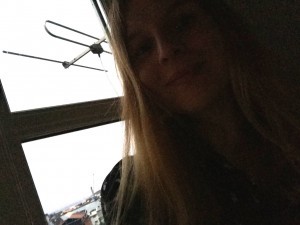
At midnight on the Faroe Islands
But oh! On the other hand: Please, try this at home. Seven entire days at a stretch, writing from eleven a.m. to eleven p.m., with no breaks to speak of, drinking large quantities of cold coffe? Definitely not a mode of operation that one should keep up long-term, and I’ll probably have to air out my brain for three weeks once I get home. But was it fun? Fun isn’t the word. I’m floating, flying, buzzing–and taking home enough energy for at least the next three albums.
The happiness researcher Mihaly Csikszentmihalyi (–Really! I’m buying a ‘Y’!–) says the basic requirement for “Flow” is to strike exactly the right balance between the degree of the challenge and your own abilities. In addition to that, you must have the opportunity to focus completely–and a clearly outlined goal for good measure. Add, last but not least, a sense of purpose and „rightness“, and voilà: it´ll all add up to a feeling of blissful, timeless delight, aka „flow.“ Check, check, check, and check, Mr. Czikszentmihalyi.
Anyway, this eruptive work, as has already been noted elsewhere, fits surprisingly well with my distance-learning program as a professional idler. Because it’s part of a really serious form of idling, I think: to work with, rather than against, your own strengths and passions. And also, conversely, not against fatigue, reluctance, or random bouts of, well, idling. That’s naturally a concept of work that, at first glance, doesn’t seem to fit well with our concept of gainful employment–but in reality it can fit better than we think. I swear.
But I digress. If you’re curious, please read my favorite ukulele-swinging philosopher Tom Hodgkinson (How to be Idle/Die Kunst des Müßiggangs), for an example.
In any case, I will further plumb the depths of activity and inactivity. At home, what comes first, no matter what: doing nothing. Accompanied by professional nose-picking.
On the eighth day, to top it all off, we go into the studio and record six of the songs, which so far we’ve only sketched out on the computer, as serious demos. To make them sound just as beautiful in real life as they do in our heads, even if it’s only for us.
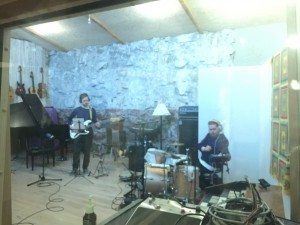
That’s only possible, of course, because all of the people who work with Teitur are professional stuntmen. They include: Jonas Bloch Danielsen, the owner of the beautiful Studio Bloch with its exposed stone wall–Jonas, who makes every shuffling foot sound like, er, an angel’s rustling wing. And makes sure that Teitur’s piano sounds… just like Teitur’s piano. And then Per I. Højgaard Petersen, the completely insane drummer, who otherwise, among other things, plays with the Salvation Army. And naturally in a death metal band. And Teitur’s girlfriend, Ingilín Strøm, who sits in the kitchen, drawing comics with her right hand and cooking incomprehensibly good food with her left.
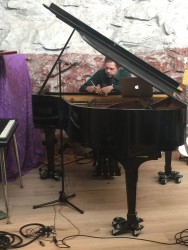
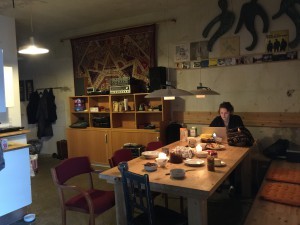

And yes, on this eighth evening, we, the stuntmen, run out of steam. We begin to dither and drivel–and there’s an ugly moment, in which we briefly believe that we might have erased everything with the brush of a stray elbow. But despite that, as I drive the next morning to the airport, I have six great recordings in hand, and there are surely things in there that will end up exactly the same way on my album.
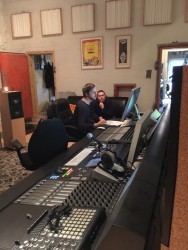
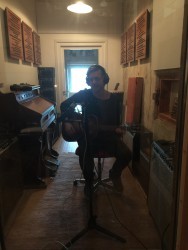
I have no idea, as yet, whom the English songs are supposed to be for. Teitur might adopt a few of them, while others sound as absurd coming out of his mouth as they do out of mine. In any case, I feel the groaning and creaking as I open locks that I have kept artificially closed for years. How many ideas have I aborted because I thought, “SOMEBODY should write a song sometime, that…” From now on, that somebody is goind to be me, even if the somebody actually has to be a man, or a teenager, or a booty-shaking American girl, or an asshole, or Lana Del Rey. Or James Taylor. Now, I’m just cranking everything out. And it’s a fair guess that, at one time or another in the process, I’ll be traveling yet again to the Faroe Islands.

—
Note: Dear oceanic friends, please don’t post any more pictures of dead whales on my blog. I know about “grindadrap.” That means: you can assume that I will address that issue if (and when) I prefer. I respect your dedication to animal welfare. In return, please respect my art and my storytelling. And my digital home.

